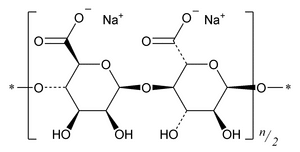Sodium Alginate
(soe' dee um al' ji nate).
DEFINITION
Sodium Alginate is the purified carbohydrate product extracted from brown seaweeds by the use of dilute alkali. It consists chiefly of the sodium salt of Alginic Acid, a polyuronic acid composed of  -d-mannuronic acid residues linked so that the carboxyl group of each unit is free while the aldehyde group is shielded by a glycosidic linkage. It contains NLT 90.8% and NMT 106.0% of sodium alginate of average equivalent weight 222.00, calculated on the dried basis.
-d-mannuronic acid residues linked so that the carboxyl group of each unit is free while the aldehyde group is shielded by a glycosidic linkage. It contains NLT 90.8% and NMT 106.0% of sodium alginate of average equivalent weight 222.00, calculated on the dried basis.
IDENTIFICATION
• A.
Sample solution:
A solution (1 in 100)
Analysis:
To 5 mL of Sample solution add 1 mL of calcium chloride TS.
Acceptance criteria:
A voluminous, gelatinous precipitate is formed immediately.
• B.
Sample solution:
A solution (1 in 100)
Analysis:
To 10 mL of Sample solution add 1 mL of 4 N sulfuric acid.
Acceptance criteria:
A heavy, gelatinous precipitate is formed.
ASSAY
• Alginates
(See Alginates Assay  311
311 .)
.)
Sample:
250 mg
Analysis:
Each mL of 0.2500 N sodium hydroxide consumed is equivalent to 27.75 mg of sodium alginate.
Acceptance criteria:
90.8%–106.0% on the dried basis
IMPURITIES
• Arsenic, Method II  211
211 NMT 1.5 ppm
NMT 1.5 ppm
• Lead  251
251
Standard solution:
5 mL of Diluted Standard Lead Solution
Test preparation:
Add 1.0 g to 20 mL of nitric acid in a 250-mL conical flask, mix, and heat carefully until the Sodium Alginate is dissolved. Continue heating until the volume is reduced to 7 mL. Cool rapidly to room temperature, transfer to a 100-mL volumetric flask, and dilute with water to volume.
Analysis:
Use 50 mL of the Test preparation, and proceed as directed in the chapter, using 15 mL of ammonium citrate solution, 3 mL of potassium cyanide solution, and 0.5 mL of hydroxylamine hydrochloride solution. After the first dithizone extraction, wash the combined chloroform layers with 5 mL of water, discarding the water layer and continuing in the usual manner by extracting with 20 mL of 0.2 N nitric acid.
Acceptance criteria:
Contains NMT 5 µg of lead (corresponding to NMT 10 ppm)
• Heavy Metals, Method II  231
231
[Note—Conduct the ignition in a platinum crucible, and use nitric acid in place of sulfuric acid to wet the test specimen. ]
Acceptance criteria:
NMT 40 ppm
SPECIFIC TESTS
• Microbial Enumeration Tests  61
61 and Tests for Specified Microorganisms
and Tests for Specified Microorganisms  62
62 :
The total bacterial count does not exceed 200 cfu/g, and the tests for Salmonella species and Escherichia coli are negative.
:
The total bacterial count does not exceed 200 cfu/g, and the tests for Salmonella species and Escherichia coli are negative.
• Loss on Drying  731
731 :
Dry a sample at 105
:
Dry a sample at 105 for 4 h: it loses NMT 15.0% of its weight.
for 4 h: it loses NMT 15.0% of its weight.
• Articles for Botanical Origin, Total Ash  561
561 :
Proceed as directed in Methods of Analysis, carefully igniting 3 g in a tared platinum dish, until the residue is thoroughly carbonized (5 min), and then igniting in a muffle furnace at a temperature of 800 ± 25
:
Proceed as directed in Methods of Analysis, carefully igniting 3 g in a tared platinum dish, until the residue is thoroughly carbonized (5 min), and then igniting in a muffle furnace at a temperature of 800 ± 25 until the carbon is completely burned off (approximately 75 min).
until the carbon is completely burned off (approximately 75 min).
Acceptance criteria:
18.0%–27.0% of ash on the dried basis
ADDITIONAL REQUIREMENTS
• Packaging and Storage:
Preserve in tight containers.
Auxiliary Information—
Please check for your question in the FAQs before contacting USP.
| Topic/Question | Contact | Expert Committee |
|---|---|---|
| Monograph | Robert H. Lafaver, M.S.
Scientific Liaison 1-301-816-8335 |
(EXC2010) Monographs - Excipients |
| Radhakrishna S Tirumalai, Ph.D.
Principal Scientific Liaison 1-301-816-8339 |
(GCM2010) General Chapters - Microbiology | |
| Radhakrishna S Tirumalai, Ph.D.
Principal Scientific Liaison 1-301-816-8339 |
(GCM2010) General Chapters - Microbiology |
USP35–NF30 Page 1950
